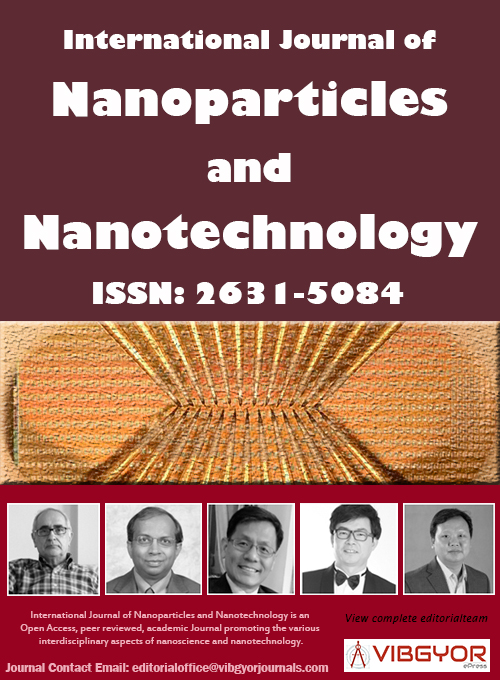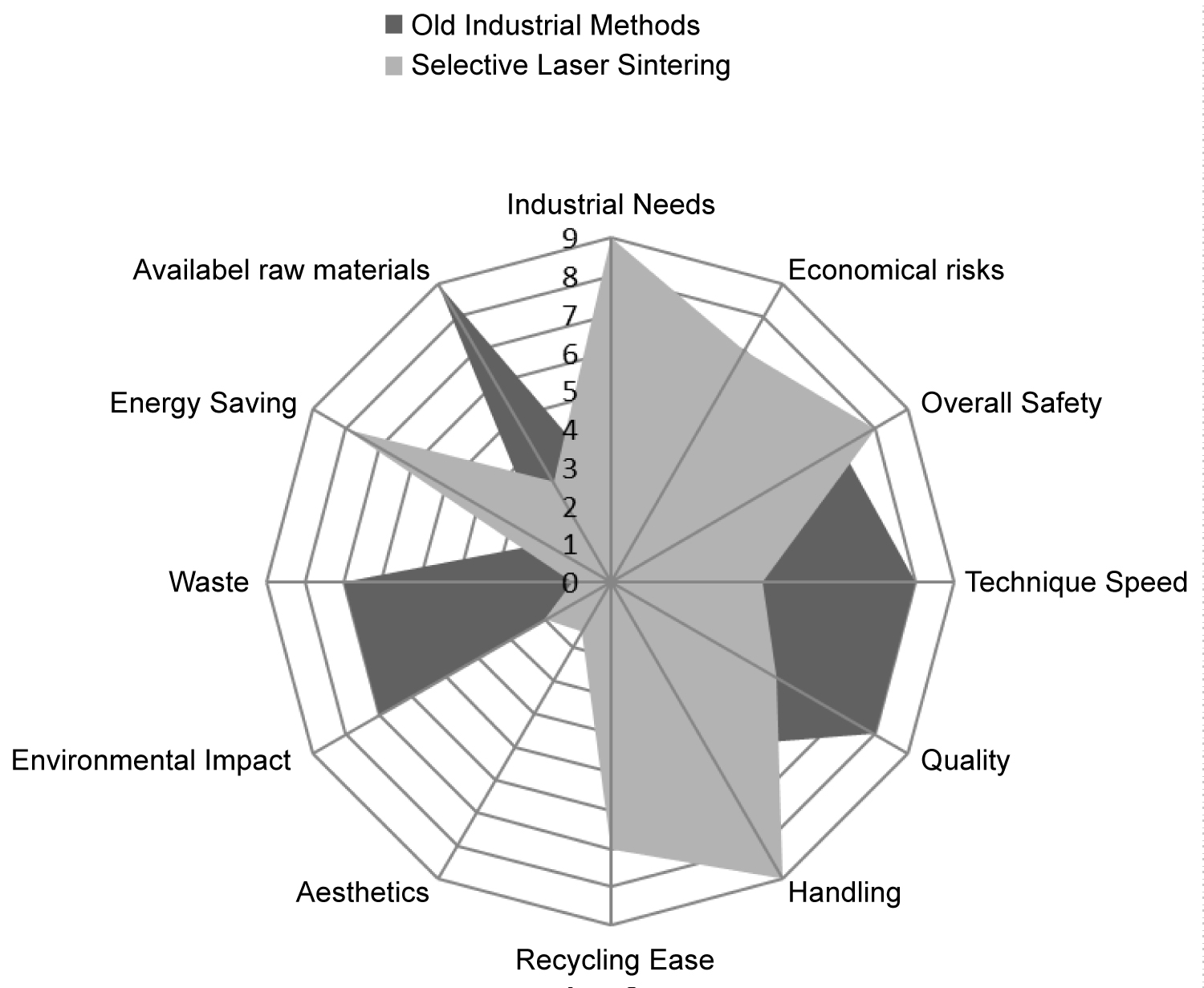
International Journal of Nanoparticles and Nanotechnology
(ISSN: 2631-5084)
Volume 5, Issue 1
Review Article
DOI: 10.35840/2631-5084/5527
3D Printing Market Uptake and Perspectives: A Position Paper
EP Koumoulos* and CA Charitidis
Table of Content
Figures

Figure 1: Radar chart of traditional industrial...
Radar chart of traditional industrial methods and SLS indicative comparison.
Tables
Table 1: The application fields and respective specific processes.
Table 2: The application fields and respective specific processes.
References
- Malte Gebler, Anton JM Schoot Uiterkamp, Cindy Visser (2014) A global sustainability perspective on 3D printing technologies. Energy Policy 74: 158-167.
- (2012) Additive manufacturing: Print me a jet engine. The Economist.
- (2012) 3D printing: A third-world dimension. The Economist.
- (2013) 3D printing scales up. The Economist.
Author Details
EP Koumoulos* and CA Charitidis
RNanolab, School of Chemical Engineering, National Technical University of Athens, Greece
Corresponding author
EP Koumoulos, RNanolab, School of Chemical Engineering, National Technical University of Athens, 9 Heroon Polytechniou St., Zographos, Athens, 15780, Greece.
Accepted: June 03, 2019 | Published Online: June 05, 2019
Citation: Koumoulos EP, Charitidis CA (2019) 3D Printing Market Uptake and Perspectives: A Position Paper. Int J Nanoparticles Nanotech 5:027.
Copyright: © 2019 Koumoulos EP, et al. This is an open-access article distributed under the terms of the Creative Commons Attribution License, which permits unrestricted use, distribution, and reproduction in any medium, provided the original author and source are credited.
Abstract
3D printing is identified to cost-effectively lower manufacturing inputs and outputs in markets with low volume, customized and high-value production chains, such as aerospace and medical component manufacturing. 3D printing has the potential to significantly lower life cycle energy demands of goods and their CO2 emissions. Moreover, Additive manufacturing will overturn many of the economics of production as it pays no heed to unit labour costs or traditional economies of scale. Advances in technology are yielding faster print times and enabling objects to be printed in greater combinations of materials, colors and finishes. Industries are nowadays at the inflection point for 3D printing. It has now moved from a new and much-hyped, but largely unproven, manufacturing process to a technology with the ability to produce real, innovative, complex and robust products.
Introduction
3D printing was introduced around the mid 80's and is currently according to the prevailing view, the starting point of a new industrial revolution. Recent spread of 3d printers is the result of the expiration of the patent for the FDM (Fused Deposition Modelling) in 2009. Respectively, at an industrial scale, similar spread of the said modelling is shown in 2014, when the patent for the SLS (Selective Laser Sintering) technology expired.
3D printing is identified to cost-effectively lower manufacturing inputs and outputs in markets with low volume, customized and high-value production chains, such as aerospace and medical component manufacturing. This method lowers energy use, resource demands and related CO2 emissions over the entire product life cycle, induces changes in labor structures and generates shifts towards a digitalized and localized supply chain. In their case study, Gebler, et al. [1] created a model showing that 3D printing has the potential to reduce costs by 170-593 billion US $, the total primary energy supply by 2.54-9.30 EJ and CO2 emissions by 130.5-525.5 Mt by 2025. The great range within the saving potentials is a result of uncertainties of predicting market and technology developments.
According to Reeves, et al. 3D printing has the potential to significantly lower life cycle energy demands of goods and their CO2 emissions. Reeves et al has also demonstrated in a case study of a structural airplane component that manufacturing-related energy demands and CO2 emissions can be lowered by up to 75%. The 3D printing-induced lightweight design further adds usage savings which amount to 63% savings in energy and CO2 emissions over the entire life cycle of the product. This shows that 3D printing has a great environmental potential beyond just the manufacturing of products [1]. The application fields and respective specific processes are outlined in Table 1.
Thus, the SLS (Selective Laser Sintering) devices are widely used in the industry for the purposes of 3d printing, which (devices) use a high-power Laser in order to fuse materials and lay them on the printing surface. This technique enables the printing of plastic, metallic, ceramic, glass and any material that exists in a powdery form and can be fused.
From Lab to Fab
Additive manufacturing will overturn many of the economics of production as it pays no heed to unit labour costs or traditional economies of scale. Designs can be quickly changed, so the technology enables flexible production and mass customization. However, even if the crucial point of a lab's printer is that it combines size and cheapness (printers used by hobbyists are not expensive, but they are small), many would find it hard to make anything larger than a coffee cup. Those used by engineering companies cost serious money-and even they might balk at printing an object the size of a small boat [2,3]. Additionally, it will be some time before the multiplicity of skills used by labourers on a building site and decision making are replaced by a 3D printer. Additive manufacturing is not about to replace mass manufacturing. Note that the finish and durability of some printed items can still fall short of what producers require and nor can 3D printers crank out zillions of identical parts at low cost, as mass-production lines can. Nevertheless, 3D printers have their virtues, which are why they are starting to be used by some of the world's biggest manufacturers, such as Airbus, Boeing, GE, Ford and Siemens [4].
Applications - Industrial Scale
3D Printing in industry is currently at a turning-point, since more and more industrial units use the said technique. The use of a 3D printer has nowadays surpassed standardization and printing of tools and small objects. The commencement of this new industrial "revolution" is confirmed in a survey conducted in 2014, in which more than 100 constructions companies participated. The research showed that 11% of the companies had already substituted the past methods by the 3D printing for mass production of individual parts or integrated products. Two years have elapsed from the said research and one can easily realize that this percentage must have certainly sprung. Indeed, according to a new PwC survey conducted at the end of 2015, it is estimated that 42% of large industries in Northern America will use SLS 3D printers for a large portion of their operations until 2020.
More companies will follow, as long as the range of printable material continues to expand. Apart from the thermoplastics already used (PLA, ABS) and the photosensitive resins, these already include ceramics, cement, glass, many metals and alloys and the new thermoplastic composites reinforced with carbon nanotubes and fibers. Despite the fact that the direct cost of the production of products with these new methods and the above materials is usually higher, the flexibility offered by the Additive Manufacturing means that the total cost may be substantially lower (Figure 1 and Table 2).
Challenges
With this revolutionary change already in motion, engineers must now focus on strategic issues at three levels:
• Construction of an object following the principles of 3D printing, according to a digital "design" which will be forwarded to a printer, opens the way not only for unlimited revision, readjustment and improvement of the product, but for more complex product design.
• How will production be optimized and how will the old and new procedures be combined?
• Financial impact on the market; since financial data rapidly change with the substitution of old techniques by 3D printing.
• Investment capital and energy; industrial production requires expensive equipment to replace traditional production lines and the energy consumption for the case of large metallic and ceramic components (e.g. due to the laser use) has to be balance with the zero waste.
• Feedstock bulk capacity; adaptability of feedstock bulk material size and shape.
• Resolution and speed; the choice of the one against the other.
Metrology/Standardization for Faster Uptake of the AM Technology
Standardisation and metrology go hand in hand for successful commercialisation of industrial products, processes and technology. Inspection, monitoring and quality assurance are critical requirements for the success of manufacturing: measurement. Metrology, the science and act of measuring, is required for technological, market and consumer confidence underpinned by standardisation. Metrology primarily assures whether object manufactured is actually suitable for the purpose intended in both functionality along with its tolerances. It is also important to control and optimize a manufacturing process towards achieving product and performance standards through appropriate metrology. This is extremely important for emerging manufacturing and product portfolios emanating from Europe's outstanding scientific and innovation value chain. While we can make some very complex and unconventional shapes and structures using, for example nanotechnology, biomimetics or additive manufacturing we are yet to put in place a robust quality assurance scheme and standardisation mainly due to lack of appropriate and enough metrological tools and methodologies. The success in setting appropriate metrology tools, techniques and methodologies in these types of products and processes is required to enable a high confidence in product, improve energy efficiency and reduce scrap material, redundant processing time, cost and environment. This can be achieved through validation of measurement procedures, new standard reference materials, metrological traceability, cross-verification through multimodal round robin testing in multiple locations.
Metrology can be on-line, in line or off-line. Europe has a leading edge in the field of metrology instrumentation and products. The field of metrological tools and methodologies however face a huge challenge with a drive towards higher value added, lower cost, complex manufacturing e. g. those foreseen in Manufacturing 4.0 initiative, or nanotechnology. Current optical, mechanical, magnetic and electrical metrological tools are not adequate to enable fast and reliable on and in line metrology in a cost-effective way as it may be required for additive manufacturing. There are only a few techniques that can measure and standardize physico-chemical properties of nanoscale materials at low dimensional measurements within a production process. For example, methods for the determination of particle size should be linked with standardized measurement techniques. Measuring texture and in-process defects largely depends on destructive and nondestructive off-line characterization techniques. This roadmap highlights the key actions required for enabling the drive towards real time in line quality assurance along with the formulation of legal-regulatory guidelines for proper standardisation.
Conclusion and Future Perspective
3D printing is a market with enormous growth potential now that the main barriers to up-take are being addressed. Advances in technology are yielding faster print times and enabling objects to be printed in greater combinations of materials, colors and finishes. Industries are nowadays at the inflection point for 3D printing. It has now moved from a new and much hyped, but largely unproven, manufacturing process to a technology with the ability to produce real, innovative, complex and robust products. Conclusively, although industrial 3D printing faces many challenges, it is said to be a matter of time until SLS technique replaces many of the old industrial methods of fabricating.

